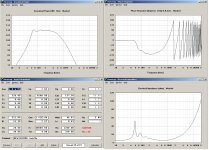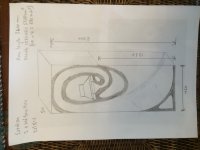Hello all,
I plan to do a exponential horn to cover 50-300Hz region.
Please be so kind and answer some questions before i start making saw dust
My previous experience with horn is limited, i only completed a 220Hz tractrix horn. I like what i hear so i thought adding horn bellow would be great. It would result a 3way active system, crossed at 300 and 2.6k Hz.
The data you see in Hornresp is not final, only Fc 50Hz and mouth area is final. I will play more with parameters so that response is ripple-free. Driver used in this sim is B&C12MH32.
Questions:
1. Look at the Hornresp simulated response. Do you think it goes low enough not to need additional subwoofers?
2. Is there any restriction on how i will bend the exponential horn? I mean the radius on the curved axial line. I liked what i saw on inlowsound's site, that spiral horn. I need to make it spiral as it is 1.8m in length.
3. The mouth ratio between height and width. Is there a recommendation?
Feel free to dismiss my project, i need advice from experienced people.
Thank you!
I plan to do a exponential horn to cover 50-300Hz region.
Please be so kind and answer some questions before i start making saw dust
My previous experience with horn is limited, i only completed a 220Hz tractrix horn. I like what i hear so i thought adding horn bellow would be great. It would result a 3way active system, crossed at 300 and 2.6k Hz.
The data you see in Hornresp is not final, only Fc 50Hz and mouth area is final. I will play more with parameters so that response is ripple-free. Driver used in this sim is B&C12MH32.
Questions:
1. Look at the Hornresp simulated response. Do you think it goes low enough not to need additional subwoofers?
2. Is there any restriction on how i will bend the exponential horn? I mean the radius on the curved axial line. I liked what i saw on inlowsound's site, that spiral horn. I need to make it spiral as it is 1.8m in length.
3. The mouth ratio between height and width. Is there a recommendation?
Feel free to dismiss my project, i need advice from experienced people.
Thank you!
Attachments
I'm not very experienced but would guess bass response would sound reasonably solid and have good dynamics
here's a little hypex horn I had built simulated with its Community 111913 12" speaker vs your horn with the same speaker. My folded horn has an external bulk of about 198 liters. A subwoofer could help in my case.

here's a little hypex horn I had built simulated with its Community 111913 12" speaker vs your horn with the same speaker. My folded horn has an external bulk of about 198 liters. A subwoofer could help in my case.

Last edited:
Maybe have a look at the azura 50 Hz L-shaped bass horn for inspiration? Details (plans and freq response) here: Azurahorn -Le Cleac'h Acoustic Horns - Products
Questions:
1. Look at the Hornresp simulated response. Do you think it goes low enough not to need additional subwoofers?
2. Is there any restriction on how i will bend the exponential horn? I mean the radius on the curved axial line. I liked what i saw on inlowsound's site, that spiral horn. I need to make it spiral as it is 1.8m in length.
3. The mouth ratio between height and width. Is there a recommendation?
1. The XO point will be at -3 to -6 dB, so this is a ~60 Hz usable horn and no, it doesn't go low enough. For most recordings it requires a ~flat in room response down to ~42 Hz and of course down to 16 hz for them all.
2. Yes, you must bend the horn to allow its highest planned frequency to go around any bend unimpeded, so look to the early W.E. horns for inspiration same as John? apparently did.
3. The pioneers determined that up to a ~1.0:1.273 aspect ratio was acceptable.
GM
I've built many horns, and I understand your desire to try and cover off this range without a sub. Physics work against you, however as GM alludes to.
I've designed two smaller horns than the Inlow large model. You could consider having this CNC'd in ply, or use John's "traditional" method. Using B&C PE32 12-inch you'll meet your target.
Andrew.
I've designed two smaller horns than the Inlow large model. You could consider having this CNC'd in ply, or use John's "traditional" method. Using B&C PE32 12-inch you'll meet your target.
Andrew.
Attachments
My understanding is that the sensitivity rating 110dB@1w is completely separate to the overall smoothness. Playing at 85 should be same as 90.Thanks Andrew,
I simulated a horn with this driver and it is very good indeed.
Flat line from 60 to 400hz at 110dB@1W.
Usually I listen at lower volumes. Do you think that the response will not be so flat when listening at let's say.. 85dB ?
I've just drawn up another horn today, while on holidays. Like Sato but for 6, 8, or 10 inch pro driver. Details to follow. Would be a CNC delight, but still exotic.
Just another idea for that specific range, hope you've already considered this classic:
http://volvotreter.de/downloads/Edgar-Show-Horn.pdf
It's kind of big but I compromised it doing a 1.4:1 clone and it became a 70-500Hz using 10-inch driver. The last bottom octaves were covered with an usual subwoofer.
http://volvotreter.de/downloads/Edgar-Show-Horn.pdf
It's kind of big but I compromised it doing a 1.4:1 clone and it became a 70-500Hz using 10-inch driver. The last bottom octaves were covered with an usual subwoofer.
I will look again..
Dorin, do you think crossing subwoofers at 100Hz is going to sound OK? What was your experience? The reason i ask, i did a little measuring in my room and if i move my office i can put thw straight 120cm horns in corner. But being so small in length, they will only go from 95Hz up..
Dorin, do you think crossing subwoofers at 100Hz is going to sound OK? What was your experience? The reason i ask, i did a little measuring in my room and if i move my office i can put thw straight 120cm horns in corner. But being so small in length, they will only go from 95Hz up..
I never completed my bass horn.
Any info I have is secondhand and mostly based on "old school" empirical design methods, except for Hornresp.
And Hornresp sort of confirmed what "old school" had suggested.
Truncating a horn leads to ripple.
One can minimise ripple by minimising the truncation. Trying horn length >=60% of the full horn length for your cut-off frequency. I think the Tannoy Westminter Royale/HR is truncuated even lower.
Choose an expansion rate that suits a frequency BELOW your cut-off frequency. Some have suggested half an octave below.
You are using 1Pi space. You are required to acoustically couple the horn to TWO boundaries. Floor and side wall are probably the easiest to couple to. That has allowed you to cut mouth area to 25% without affecting response.
Look at cone excursion for frequencies below your cut-off. They are likely to be frighteningly large due to the truncated horn unloading at these lower frequencies. I think it is for this reason that GM and Atil are suggesting your horn is too small.
Have you looked at firing the horn into a corner?
That would require your other speaker to extend down to upper bass.
Any info I have is secondhand and mostly based on "old school" empirical design methods, except for Hornresp.
And Hornresp sort of confirmed what "old school" had suggested.
Truncating a horn leads to ripple.
One can minimise ripple by minimising the truncation. Trying horn length >=60% of the full horn length for your cut-off frequency. I think the Tannoy Westminter Royale/HR is truncuated even lower.
Choose an expansion rate that suits a frequency BELOW your cut-off frequency. Some have suggested half an octave below.
You are using 1Pi space. You are required to acoustically couple the horn to TWO boundaries. Floor and side wall are probably the easiest to couple to. That has allowed you to cut mouth area to 25% without affecting response.
Look at cone excursion for frequencies below your cut-off. They are likely to be frighteningly large due to the truncated horn unloading at these lower frequencies. I think it is for this reason that GM and Atil are suggesting your horn is too small.
Have you looked at firing the horn into a corner?
That would require your other speaker to extend down to upper bass.
Last edited:
(btw, the Showhorn mouth area is too small i think).
If you read its presentation carefuly you would learn that it's meant for 1/8 loading, put in a corner of the room.
A two foot gap from the mouth edge to the boundary is not negligible.
If it is a near square mouth then all four edges should be acoustically coupled to the three boundaries for a 0.5Pi loading.
I can only see that being met by a mouth firing into the corner where the gaps to the corner boundaries meet the "folded" form of the extended horn, or by building the mouth into the corner, i.e. the horn box is outside the listening room.
It's the same for a speaker baffle that is not built into the boundary wall. If one mounts the speaker baffle flush with the boundary wall then baffle step response does not occur. Build the box inside the room and the baffle step has to be compensated for. Even when the box places the baffle just a foot in front of the boundary wall.
If it is a near square mouth then all four edges should be acoustically coupled to the three boundaries for a 0.5Pi loading.
I can only see that being met by a mouth firing into the corner where the gaps to the corner boundaries meet the "folded" form of the extended horn, or by building the mouth into the corner, i.e. the horn box is outside the listening room.
It's the same for a speaker baffle that is not built into the boundary wall. If one mounts the speaker baffle flush with the boundary wall then baffle step response does not occur. Build the box inside the room and the baffle step has to be compensated for. Even when the box places the baffle just a foot in front of the boundary wall.
Last edited:
- Status
- This old topic is closed. If you want to reopen this topic, contact a moderator using the "Report Post" button.
- Home
- Loudspeakers
- Multi-Way
- 50-300Hz front horn

